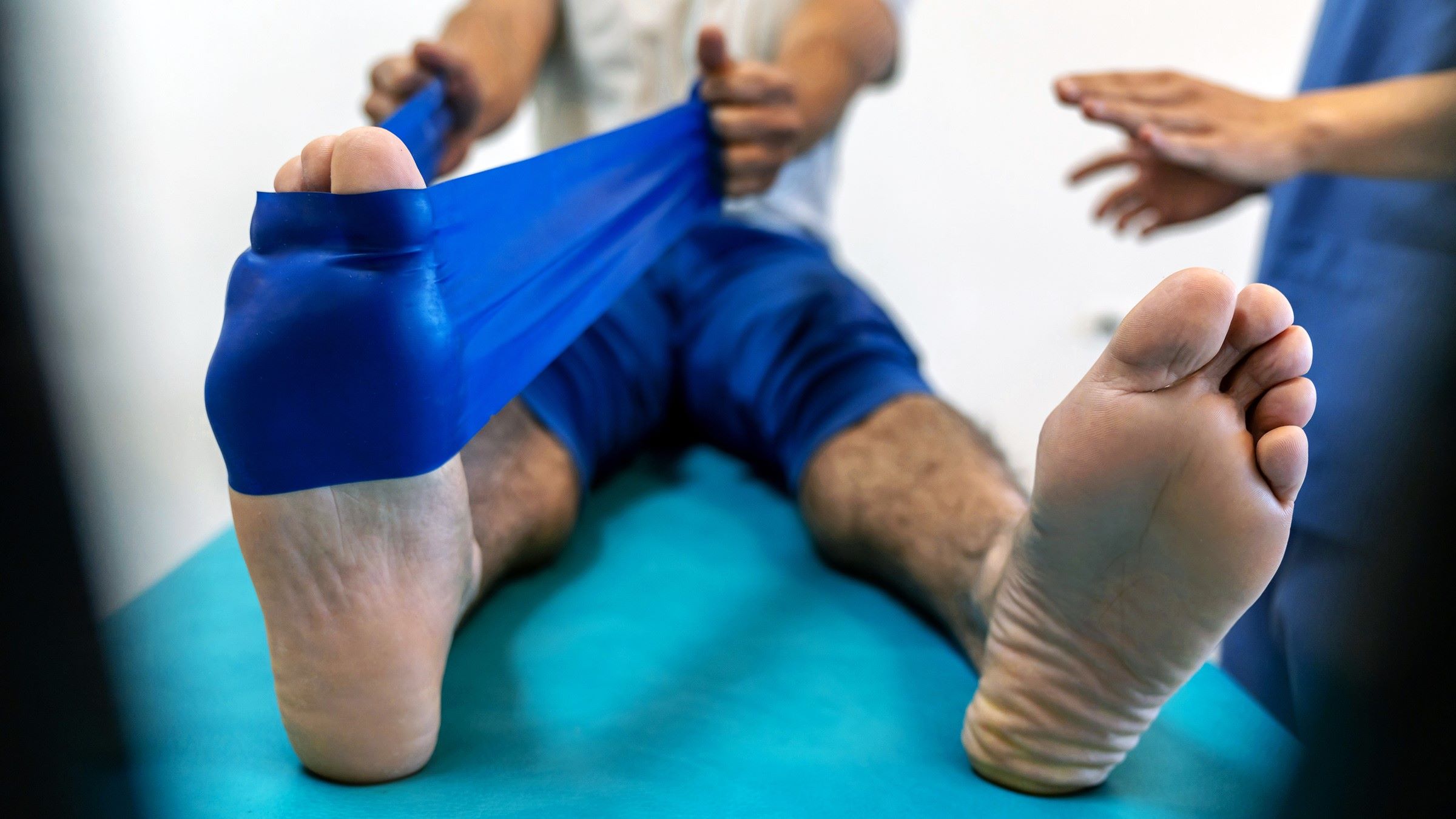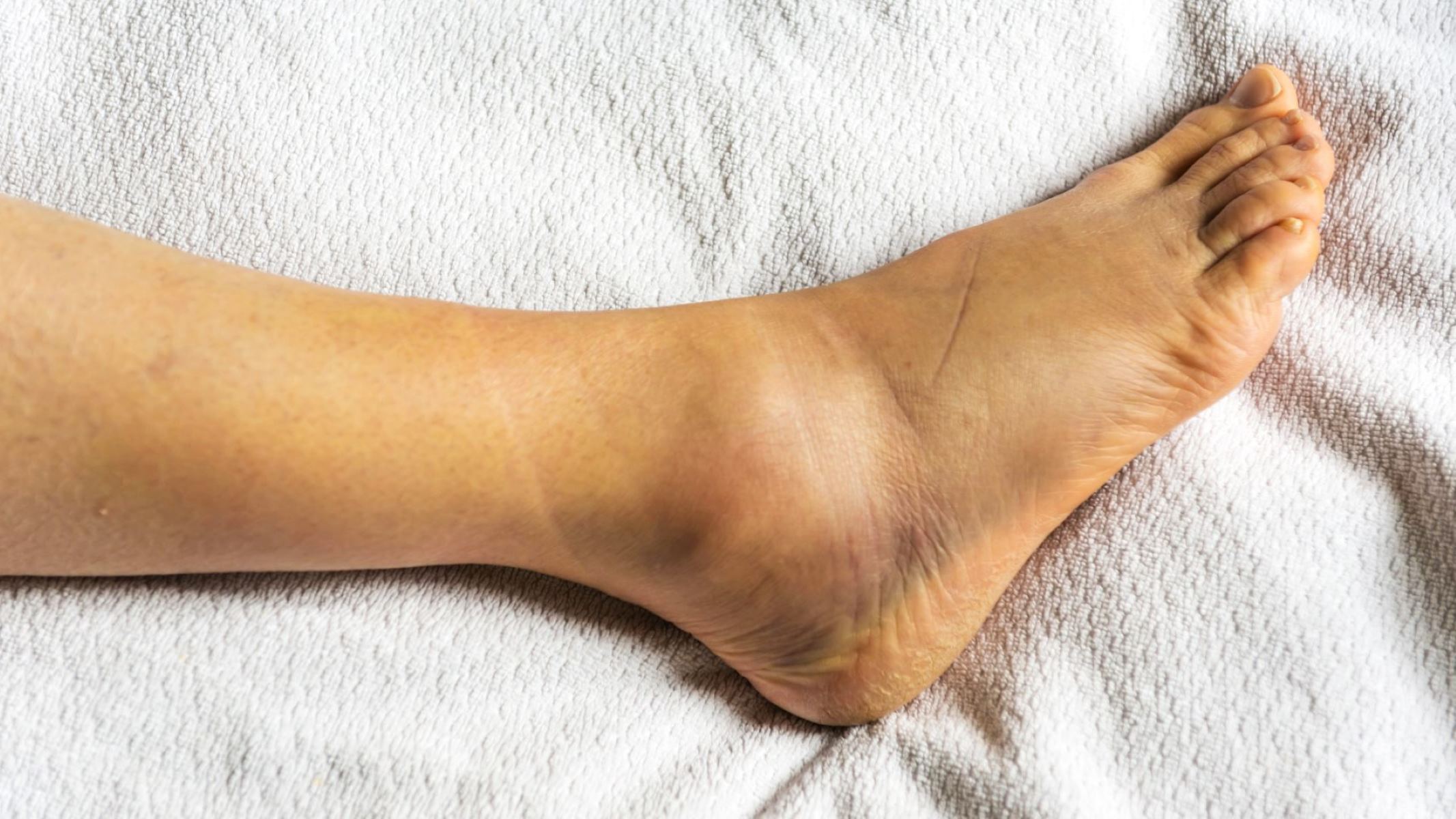Home>Health & Nutrition>Injury Prevention>What To Do If You Suspect An Ankle Sprain


Injury Prevention
What To Do If You Suspect An Ankle Sprain
Published: February 25, 2024
Learn how to prevent ankle sprains and what to do if you suspect an injury. Get expert tips on injury prevention and treatment.
(Many of the links in this article redirect to a specific reviewed product. Your purchase of these products through affiliate links helps to generate commission for Therunningadvisor.com, at no extra cost. Learn more)
Table of Contents
Understanding Ankle Sprains
Ankle sprains are one of the most common injuries, often occurring during physical activities, sports, or even simple daily movements. Understanding the nature of ankle sprains is crucial for effective prevention and treatment.
An ankle sprain happens when the ligaments that support the ankle stretch or tear, usually due to sudden twisting or rolling of the foot. The ligaments are tough bands of tissue that connect the bones and provide stability to the joint. When these ligaments are forced beyond their normal range of motion, it can result in varying degrees of injury.
There are different grades of ankle sprains, ranging from mild to severe. A mild sprain involves slight stretching and minimal tearing of the ligament fibers, causing mild pain and swelling. In contrast, a severe sprain involves significant tearing of the ligaments, leading to intense pain, swelling, and instability of the ankle joint.
Understanding the mechanism of ankle sprains is essential for injury prevention. Factors such as inadequate warm-up, improper footwear, uneven surfaces, and muscle weakness can contribute to the risk of experiencing an ankle sprain. Additionally, individuals with a history of previous ankle sprains may be more susceptible to re-injury if proper precautions are not taken.
By recognizing the common causes and risk factors associated with ankle sprains, individuals can take proactive measures to minimize the likelihood of experiencing this type of injury. This may include incorporating strengthening and balance exercises into their fitness routine, wearing supportive footwear, and being mindful of their movements during physical activities.
Understanding the impact of ankle sprains on daily life and physical performance is also important. Even a mild sprain can lead to discomfort and limitations in mobility, affecting one's ability to engage in regular activities. Therefore, being aware of the potential consequences of ankle sprains underscores the significance of implementing preventive strategies and seeking appropriate treatment when necessary.
In summary, understanding the nature of ankle sprains, including their causes, severity, and potential impact, is fundamental for promoting injury prevention and prompt intervention. By gaining insight into the mechanics of ankle sprains, individuals can take proactive steps to safeguard their ankle health and overall well-being.
Signs and Symptoms of Ankle Sprains
Ankle sprains can manifest a range of signs and symptoms, serving as crucial indicators of the extent of the injury and guiding appropriate treatment measures. Recognizing these manifestations is essential for prompt and effective management of ankle sprains.
-
Pain and Tenderness: One of the primary symptoms of an ankle sprain is pain, which can vary from mild discomfort to severe throbbing. The affected area may also exhibit tenderness upon touch, indicating the localized sensitivity of the injured ligaments.
-
Swelling: Ankle sprains often lead to swelling around the affected joint. This occurs as a result of the body's natural response to tissue damage, leading to the accumulation of fluid in the injured area. The degree of swelling can vary depending on the severity of the sprain.
-
Bruising: In many cases, bruising or discoloration may develop around the ankle following a sprain. This occurs due to the leakage of blood from damaged blood vessels into the surrounding tissues, resulting in visible skin discoloration.
-
Instability and Weakness: Ankle sprains can cause instability and weakness in the affected joint, making it challenging to bear weight or maintain balance. Individuals may experience a sense of wobbliness or unsteadiness when attempting to stand or walk.
-
Limited Range of Motion: The range of motion in the ankle joint may be restricted following a sprain. This limitation can be attributed to pain, swelling, and the body's protective response to prevent further injury, thereby affecting the flexibility and mobility of the ankle.
-
Popping Sensation: Some individuals may experience a popping or tearing sensation at the time of injury, indicating the abrupt stretching or tearing of the ligaments. This sensation is often accompanied by immediate pain and discomfort.
-
Difficulty Bearing Weight: Ankle sprains can make it difficult to bear weight on the affected foot. This can significantly impact mobility and daily activities, prompting individuals to favor the uninjured foot to alleviate discomfort.
Recognizing these signs and symptoms is crucial for accurately assessing the severity of an ankle sprain and determining the appropriate course of action. By being attentive to these manifestations, individuals can seek timely medical evaluation and implement targeted interventions to facilitate the healing process and prevent potential complications.
Initial Steps for Treating Ankle Sprains
Upon experiencing an ankle sprain, immediate and appropriate measures can significantly influence the recovery process and minimize the risk of complications. The initial steps for treating ankle sprains encompass a combination of self-care strategies aimed at alleviating pain, reducing swelling, and promoting the healing of the injured ligaments.
Rest and Elevation
One of the first and most crucial steps in managing an ankle sprain is to rest the affected foot. By minimizing weight-bearing activities and avoiding strenuous movements, individuals can prevent further stress on the injured ligaments, allowing the healing process to commence. Additionally, elevating the injured ankle above heart level can help reduce swelling and alleviate discomfort. This position facilitates the drainage of excess fluid from the injured area, promoting a reduction in swelling and enhancing overall comfort.
Ice Application
The application of ice to the injured ankle is an effective method for reducing swelling and managing pain. Cold therapy helps constrict blood vessels, thereby limiting the accumulation of fluid in the injured tissues and diminishing inflammation. It is recommended to apply an ice pack or cold compress to the affected area for 15-20 minutes at a time, several times a day, particularly within the initial 48 hours following the sprain.
Read more: Race Nutrition: What To Do And What To Avoid
Compression
Utilizing a compression bandage or elastic wrap around the injured ankle can provide support and minimize swelling. The gentle pressure exerted by the compression bandage helps restrict the movement of the injured ligaments, reducing the risk of further damage and promoting stability. It is important to ensure that the compression is snug but not excessively tight, as excessive pressure can impede blood circulation.
Immobilization
In cases of moderate to severe ankle sprains, immobilization may be necessary to prevent excessive movement and facilitate proper healing. This can be achieved through the use of a supportive brace or splint, which helps stabilize the ankle joint and restricts unnecessary motion. Immobilization aids in protecting the injured ligaments from additional strain, promoting a more efficient recovery process.
Over-the-Counter Pain Relief
Over-the-counter nonsteroidal anti-inflammatory drugs (NSAIDs) such as ibuprofen or naproxen can be utilized to manage pain and reduce inflammation associated with ankle sprains. These medications can help alleviate discomfort and enable individuals to engage in essential daily activities with greater ease.
By promptly implementing these initial treatment steps, individuals can effectively manage the immediate impact of an ankle sprain and lay the foundation for a smoother recovery journey. These measures not only address the acute symptoms of the injury but also contribute to the overall healing and restoration of ankle function.
When to Seek Medical Attention for Ankle Sprains
While many ankle sprains can be effectively managed through self-care measures, there are instances where seeking medical attention is essential to ensure proper evaluation and treatment. Understanding the indications for seeking medical assistance is crucial for safeguarding the long-term health and functionality of the injured ankle.
Read more: Summer Running: What To Do And What To Avoid
Persistent or Severe Pain
If the pain associated with the ankle sprain persists or intensifies despite initial self-care efforts, it is advisable to consult a healthcare professional. Persistent and severe pain may signify a more significant injury, such as a severe ligament tear or a potential fracture, necessitating a comprehensive assessment by a medical provider.
Inability to Bear Weight
Individuals who find it challenging or impossible to bear weight on the injured foot should seek medical attention promptly. Difficulty in bearing weight may indicate a more severe sprain or the presence of additional structural damage within the ankle joint, requiring thorough examination and appropriate management.
Significant Swelling and Bruising
Excessive swelling and extensive bruising around the ankle following a sprain may indicate a more severe injury than initially perceived. If the swelling and bruising do not show signs of improvement within the first few days or if they worsen over time, it is advisable to seek medical evaluation to rule out potential complications and ensure proper treatment.
Persistent Instability or Weakness
An ongoing sense of instability or weakness in the ankle joint, particularly beyond the initial phase of the injury, warrants medical attention. Prolonged instability may indicate underlying ligament damage that requires specialized care to facilitate optimal healing and restore the stability of the joint.
Limited Range of Motion
If the range of motion in the injured ankle remains significantly restricted despite self-care measures, it is advisable to consult a healthcare professional. Persistent limitations in mobility may indicate the presence of scar tissue, joint stiffness, or other factors that necessitate targeted interventions to restore full functionality.
Previous History of Ankle Injuries
Individuals with a history of recurrent ankle sprains or previous ankle injuries should consider seeking medical attention, even if the current injury appears mild. A healthcare provider can assess the overall stability of the ankle, identify potential underlying issues, and recommend preventive measures to reduce the risk of future injuries.
Underlying Health Conditions
For individuals with pre-existing medical conditions such as diabetes, peripheral neuropathy, or circulatory disorders, seeking medical evaluation for an ankle sprain is crucial. These conditions can impact the healing process and increase the risk of complications, necessitating specialized care and monitoring.
Professional Evaluation and Guidance
Ultimately, seeking medical attention for an ankle sprain provides the opportunity for a professional evaluation, accurate diagnosis, and personalized treatment recommendations. Healthcare providers can offer tailored guidance on rehabilitation exercises, assistive devices, and preventive strategies, ensuring a comprehensive approach to recovery and minimizing the likelihood of long-term complications.
By recognizing the aforementioned signs and circumstances, individuals can make informed decisions regarding the appropriate timing for seeking medical attention following an ankle sprain. Prioritizing timely evaluation and intervention can contribute to a more effective recovery process and promote the long-term health and stability of the injured ankle.
Read more: Running And Bunions: What You Need To Know
Rehabilitation and Recovery for Ankle Sprains
Rehabilitation and recovery play a pivotal role in the comprehensive management of ankle sprains, aiming to restore strength, flexibility, and functionality to the injured joint while minimizing the risk of recurrent injuries. The rehabilitation process for ankle sprains encompasses a structured approach that integrates therapeutic exercises, gradual progression of activities, and targeted interventions to facilitate optimal healing and long-term stability.
Early Phase: Restoring Mobility and Reducing Swelling
During the initial phase of rehabilitation, the focus is on reducing swelling, restoring mobility, and initiating gentle exercises to promote circulation and prevent stiffness. RICE (Rest, Ice, Compression, Elevation) therapy continues to be beneficial in managing swelling and discomfort. Additionally, gentle range of motion exercises, such as ankle circles and toe movements, can help maintain flexibility and prevent joint stiffness.
Strengthening and Stability Exercises
As the acute symptoms subside, the rehabilitation program progresses to include strengthening and stability exercises. This phase aims to rebuild the strength of the ankle and surrounding muscles, enhancing the overall stability of the joint. Exercises such as calf raises, ankle dorsiflexion and plantarflexion movements, and resistance band exercises are incorporated to target the specific muscle groups involved in ankle stability.
Balance and Proprioception Training
Improving balance and proprioception is a key component of ankle sprain rehabilitation. Proprioception refers to the body's awareness of its position in space, and enhancing this sensory feedback is crucial for preventing future sprains. Balance exercises, such as single-leg stands and wobble board activities, are employed to challenge the ankle's stability and enhance proprioceptive capabilities.
Gradual Return to Activities
As the ankle gains strength and stability, a gradual return to weight-bearing activities and functional movements is initiated. This phase involves a progressive reintroduction of activities such as walking, jogging, and agility drills, tailored to the individual's recovery timeline and functional goals. It is essential to monitor for any signs of discomfort or instability during this phase and adjust the intensity of activities accordingly.
Preventive Measures and Long-Term Management
Rehabilitation for ankle sprains extends beyond the immediate recovery period, emphasizing the implementation of preventive measures and long-term management strategies. This may involve ongoing strength and flexibility exercises, the use of supportive footwear or orthotics, and the incorporation of ankle-specific training into regular fitness routines. Additionally, individuals are encouraged to maintain a proactive approach to injury prevention, such as avoiding uneven surfaces and being mindful of foot positioning during physical activities.
Professional Guidance and Monitoring
Throughout the rehabilitation process, seeking guidance from a healthcare professional, such as a physical therapist or sports medicine specialist, can provide valuable support and personalized recommendations. These professionals can offer tailored exercise programs, manual therapy techniques, and ongoing monitoring to ensure the effective progression of rehabilitation and address any potential setbacks.
In summary, the rehabilitation and recovery journey following an ankle sprain encompasses a multifaceted approach, integrating progressive exercises, functional training, and preventive strategies to promote optimal healing and long-term ankle stability. By adhering to a structured rehabilitation program and seeking professional guidance, individuals can enhance their recovery outcomes and minimize the risk of recurrent injuries, ultimately fostering a return to pain-free mobility and physical activity.











